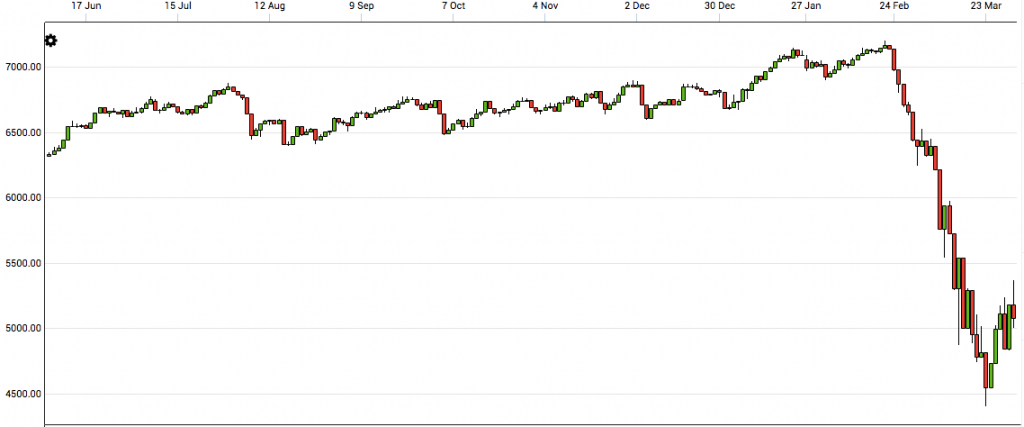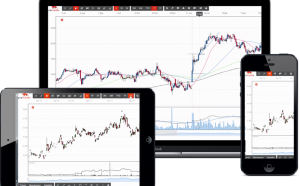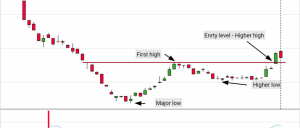XJO Down 1362.
Covid-19 Infects International Markets
The 576 point fall in February proved to be just the start, with March extending the longest losing streak since September 2018 (US/China Trade War) dropping another 1362 points.
Domestic issues had virtually no influence on the Australian market with Covid-19 and the US (the engine of the world economy) dominating International stock market direction.
Despite the Reserve bank dropping Interest rates twice in March, the 2nd drop on the 20th to a historically low .25%, and the Australian Government releasing a series of stimulus packages all eyes were on the US.
Black Monday 9th March
Infection rates and deaths soared over the weekend in Italy & the US, which caused sellers to move in, locking in gains made the previous week. With unbridled fear gripping Asian markets, after China announced a historical drop in Industrial production of 20.5% the XJO had its single worse trading session loss in 12 years, dropping 456 point and closing on the session low of 5760.
The remainder of the week experienced extreme volatility as differing opinions between people trying to pick the bottom, and selling due to uncertainty caused wild swings.
Thursday the 12th nearly eclipsed Monday with the market falling a further 421 points in the session, before Friday experienced a dramatic 666 point trading day range, finishing the day up 235 points.
Black Monday 2 : 16th March
However the confidence that sparked the afternoon session rally on Friday completely evaporated over the weekend.
From the very start of trading on Monday the market headed in one direction resulting in the biggest single session drop since 1987, losing 537 points (9.7%).
The XJO continued to head south, reaching the lowest level since Dec 2012, until the US Government stimulus package was released over the 22nd/23rd weekend, which provided some confidence to the Australian market going into the final week of March with the 24th marking the turning point and a solid gain of 263 points, then followed up by the biggest single day gain in 23 years, of 339 points on the 30th March, however the month finished at 5076, down 21% for the month.
- Aus Retail Sales dropped
- Aus GDP grew -Beating forecasts ;2.2%
- Aus Manufacturing Contracted
DJI 12 MONTH CHART
The Dow Jones Industrial Average infected by Covid-19 panic continued with the sell off that began on Feb 21st creating a series of unwanted records throughout the month of March, before setting another more positive record towards the end to settle at 21,917.
Covid-19, US government response, and uncertainty were the key themes driving the market for the remainder of March.
Black Monday 9th March
- Dow Plummeted 1800 points at open.
- Losing more than 2000 points for the session
- The biggest Intraday fall in history
The market then bounced slightly on Tuesday before falling 5.9% on Wednesday.
Black Thursday 12th March
- Largest single day % drop since 1987 (10%)
With WHO then declaring / confirming that Covid-19 a Pandemic, US infection rates soaring, and the US announcing international flight restrictions, buyers totally abandoned the Dow resulting in a further 17% fall from the 16th to the 20th March.
Finally, over the 21st/.22nd weekend all arms and factions of the US Government went into action releasing a series of announcements and policies/packages.
- Fed Reserve declared all out War against Covid-19.: $700b Quantitate Package
- Trump declared Covid -19 a “National Emergency”: Freeing up Federal Funds
- US Senate passed $2 Trillion Stimulus Package
Consequently the DOW then had its biggest weekly gain from the 23rd – 27th since 1938 recovering 12.8 %, and treaded water for the remainder of March to close at 21,917.
As the month closed another record was created with the biggest jump in unemployment claims in history : 3,000,000 in one week.
Key Economic Events and Indicators
- US Feb Employment figures beat market expectations
- US 1st March Jobless claims actually decreased: 211,000
- US Feb Unemployment rate dropped back to 3.5%
- US Manufacturing expanded in Feb, Beating Market Expectations
- US Feb Durable Goods Orders jumped 1.2%
- US 4th QTR GDP 2.1%: Unchanged
- Fed Reserve dropped Interest rates to .25%
OIL PRICE UPDATES: A Lemmings Stampede
WTI Crude – Dropped $23.08 : $43.70 – $ 20.62
If the demand side concerns centred around the international economy in February coupled with the devastating impact of Covid-19 weren’t enough for International Oil markets to deal with, simmering tension between OPEC and Russia exploded in the first week of March resulting in the second largest single session drop (24.59%) in history
OIL PRICE UPDATES: Biggest One Day Percent Drops in Oil Prices
Dispute Background
Over the last several years Saudi Arabia has born the brunt of OPEC production cut backs in order to provide support to International Oil markets. Russia has been working with OPEC to support this supply side strategy.
However, smarting from the previous decades of pain inflicted by the hand of OPEC, and empowered by IP’d fracking/shale Oil extracting technology, the US over the past 24 months has turned Oil markets on it’s head, becoming the world’s leading producer, an Oil exporter for the first time in a 100 years, and annihilating Russian market share in the process.
Dispute Explodes
With suspicions that Russia may have had some involvement either logistically or materially in the attacks upon Saudi Arabian Oil facilities in November from both Iran and Libya, Saudi Arabia entered the March “OPEC + ” meeting in Vienna intent on pushing through further production reduction targets for the remainder of 2020.
Russia (fearful of their rapidly diminishing market share) flatly refused, and effectively withdrew from the “OPEC + “relationship/agreement, resulting with the Saudi representative stating this was a “declaration of war”, and Saudi Arabia will “flood the market, threatening a price war”.
Fallout
The fallout was swift and dramatic, with Saudi Arabia declaring as of April 1st:
- Increase production by 2.5 mbpd
- Total production at least 13 mbpd
- Will provide an immediate $8 per barrel discount to selected sovereign clients.
It is important to understand that this has happened all before, the last time these two major players entered an Oil war in 1985 -1986 Saudi Arabia flooded world markets causing Oil prices to disintegrate, and some people, claiming; greatly contributing to the collapse of the Soviet Union.
Furthermore, there is the added geopolitical factor of the Iran /Saudi Arabia – Shia/Sunni proxy wars, with other Gulf States such as Abu Dhabi getting in on the act by increasing production 5 fold.
The Gulf states are sending a message -If you want a war we will give you a war. We have the lowest production costs, best transport infrastructure and international relations.
Oil Finished the month at $20.62, down an eye watering 53%, and a mind blowing 68% since January,
$20 is a long tern support level going back to the 1990’s/80’s, however only time will tell if Oil producers continue to hurl them selves off the cliff.
Key Oil Price Influences
- US rig Count drops to 792
- US Oil stocks increase by 4 mb
- US Remains worlds largest producer




